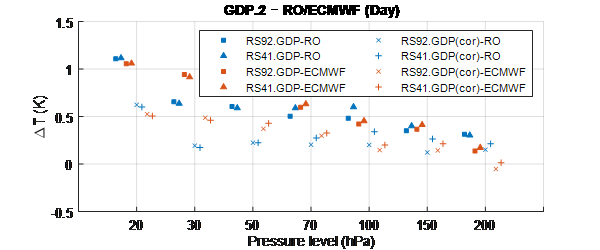Figure. Results of bias (GDP.2–RO/ECMWF) for all-day (a), daytime (b), and night-time (c). The blue and red squares indicate bias (RS92.GDP.2 original–RO) and bias (RS92.GDP.2 original–ECMWF), respectively, and the blue and red ‘x’ indicate bias (RS92.GDP.2 corrected–RO) and bias (RS92.GDP.2 corrected–ECMWF), respectively. The blue and red triangles indicate bias (RS41.GDP.2 original–RO) and bias (RS41.GDP.2 original–ECMWF), respectively, and the blue and red crosses indicate bias (RS41.GDP.2 corrected–RO) and bias (RS41.GDP.2 corrected–ECMWF), respectively.
ESSIC/CISESS Scientists Xin Jing, Xi Shao, Tung-Chang Liu and Bin Zhang (STAR/SOCD) have a new article in the July 2021 issue of Atmosphere titled “Comparison of GRUAN RS92 and RS41 Radiosonde Temperature Biases”.
This article describes the validation of the consistency of the GCOS Reference Upper Air Network (GRUAN) RS92 and RS41 datasets, versions EDT.1 and GDP.2, in the upper troposphere and lower stratosphere (200–20 hPa). Vaisala RS92 was the operational radiosonde used by GRUAN, which was transitioned to Vaisala RS41 after two years of using both radiosondes. The validation data came from the dual launch campaigns at the GRUAN site and using the radio occultation (RO) product and the ERA5 reanalysis from ECMWF as standards for double difference comparison. Separate comparisons with the references were also performed in order to trace the origin of the bias between the two instruments. Then, the performance of the GRUAN raw temperature correction algorithm was evaluated, from the aspects of day–night, the solar zenith angle, and the pressure level, for GDP.2 version products.
The results show that RS92.EDT.1 has a warm bias of 0.355 K, compared to RS41.EDT.1, at 20 hPa, during daytime. This bias was found to mainly originate from RS92.EDT.1, based on the separate comparison with RO or ECMWF ERA5 data. RS92.GDP.2 is consistent with RS41.GDP.2, but a separate comparison indicated that the two original GDP.2 products have a ~1 K warm bias at 20 hPa during daytime, compared with RO or ECMWF ERA5 data. The GRUAN correction method can reduce the warm bias up to 0.5 K at 20 hPa during daytime. As a result, this GRUAN correction method is efficient, and it is dependent on the solar zenith angle and pressure level.
Xin Jing is an assistant scientist researcher at the University of Maryland. Her current research interests include CRTM model-based validation and radiometric performance monitoring for atmospheric temperature/humidity profiles retrieved from Radio Occultation measurement through inter-comparison with microwave (MW) and infrared (IR) sensor measurements and vicarious calibration, temporal trending, and validation of GEO/LEO sensors.
Xi Shao is an associate research scientist at ESSIC/CISESS and Department of Astronomy of University of Maryland. He supports radiometric calibration and validation work for Suomi-NPP and NOAA-20 Visible Infrared Imaging Radiometer Suite (VIIRS) instrument and METimage on EPS-SG.
Tung-Chang Liu is an assistant research scientist at the University of Maryland, College Park, Maryland USA. His research interests include laser plasma interaction and laser proton accelerator design and applications, remote sensing imagery data analysis and correction, and modeling of calibration systems for imaging sensors.
Bin Zhang is an ESSIC/CISESS assistant research scientist. His research interests include ocean circulation dynamics and ocean state forecasting, satellite sensor calibration/validation.
To access the article, click here: “Comparison of GRUAN RS92 and RS41 Radiosonde Temperature Biases”.









